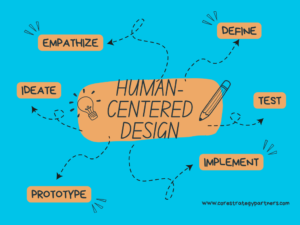Human-Centered Design – What is it and Why is it Important?

Human-centered design (HCD) is a problem-solving approach that puts people at the center of the design process. It involves understanding people’s needs, motivations, and behaviors in order to create products and services that are useful, usable, and enjoyable. As a women-owned minority business that focuses on HCD, we have seen firsthand the power of this approach to transform the way companies operate and the impact it can have on the services they provide.
At the heart of HCD is empathy. Empathy is the ability to understand and share the feelings of another person. In the context of design, empathy means putting yourself in the shoes of the people who will be using the product or service you are designing. This means understanding their needs, desires, frustrations, and motivations. By taking an empathetic approach, you can create solutions that truly meet the needs of the people you are designing for.
HCD is important when improving services within a company for several reasons. First and foremost, it helps to ensure that the services being provided are actually meeting the needs of the people who are using them. This may seem obvious, but all too often, companies design services based on assumptions or what they think people want, rather than actually understanding their needs. By taking an empathetic approach and really listening to what people need and want, companies can create services that truly meet their customers’ needs.
Secondly, HCD can help companies differentiate themselves from their competitors. By creating services that are designed with the customer in mind, companies can create experiences that are unique and delightful. This can help to build brand loyalty and increase customer satisfaction. In today’s crowded marketplace, it’s more important than ever to differentiate yourself from the competition, and HCD can be a powerful way to do that.
Thirdly, HCD can help companies identify areas for improvement in their existing services. By taking an empathetic approach and really understanding the needs of their customers, companies can identify pain points and areas where their services are falling short. This can help them to make targeted improvements that will have a big impact on customer satisfaction.
Finally, HCD can lead to more innovation. By focusing on the needs of people and really understanding their context and motivations, companies can create solutions that are truly novel and innovative. This can help to drive growth and create new opportunities for the company.
So, how does HCD work in practice? The process typically starts with research. This might involve interviews, surveys, or observations of people using the existing service. The goal is to understand the needs, desires, and pain points of the people who will be using the service.
Once the research is complete, the design team will typically move on to ideation. This is where they generate ideas for how to solve the problems, they have identified during the research phase. The goal is to generate as many ideas as possible, without worrying too much about whether they are feasible or practical.
Next comes prototyping. This is where the design team creates a rough prototype of the solution they have come up with. The goal of prototyping is to test the solution with real users and get feedback on how it can be improved.
Finally, the design team will iterate on the solution based on the feedback they have received during the prototyping phase. This might involve making tweaks to the design, adding new features, or even going back to the research phase to better understand the needs of the users.
There are several key principles that underpin HCD. These principles are essential to creating solutions that are truly human-centered. Here are some of the key principles of HCD:
- Empathy: As mentioned earlier, empathy is at the heart of HCD. It is essential to understand the needs, desires, and motivations of the people you are designing for.
- Co-creation: Co-creation is the idea that the design process should involve the people who will be using the service. This means that users should be involved in the research, ideation, and prototyping phases of the design process. This helps to ensure that the solution truly meets the needs of the people it is designed for.
- Iteration: The design process is not a linear process. Instead, it involves a lot of iteration and feedback. This means that the design team should be constantly testing and refining their solution based on feedback from users.
- Prototyping: Prototyping is an essential part of the design process. It allows the design team to quickly test and iterate on their solution, and get feedback from users in a low-risk environment.
- Multidisciplinary teams: HCD typically involves a team of designers, researchers, engineers, and other stakeholders. This multidisciplinary approach helps to ensure that the solution is feasible, viable, and desirable.
So, why is HCD important for companies? Well, as we mentioned earlier, it can help companies create services that truly meet the needs of their customers. This can lead to higher customer satisfaction, loyalty, and ultimately, business growth. In addition, HCD can help companies differentiate themselves from their competitors, identify areas for improvement in their existing services, and drive innovation.
Here are some examples of companies that have used HCD to transform the services they provide:
- Airbnb: Airbnb is a great example of a company that has used HCD to create a unique and delightful experience for its users. By taking an empathetic approach and really understanding the needs of its users, Airbnb has created a service that is both functional and enjoyable.
- IDEO: IDEO is a design firm that has been at the forefront of the HCD movement for many years. They have worked with a wide range of clients to create solutions that are truly human-centered.
- USAA: USAA is a financial services company that has used HCD to create services that meet the unique needs of military personnel and their families. By taking an empathetic approach and really understanding the needs of this group, USAA has created services that are both useful and meaningful.
In conclusion, human-centered design is a powerful approach to problem-solving that can help companies create services that truly meet the needs of their customers. By taking an empathetic approach and really understanding the needs, desires, and motivations of the people who will be using the service, companies can create solutions that are useful, usable, and enjoyable. This can lead to higher customer satisfaction, loyalty, and ultimately, business growth. If you’re interested in learning more about HCD and how it can help your company, we’d be happy to chat with you!
